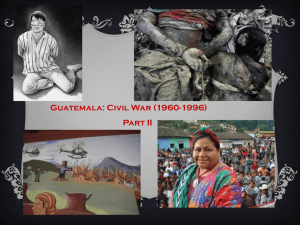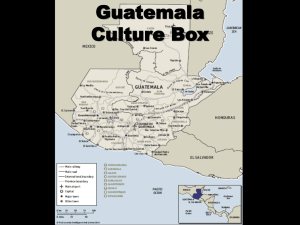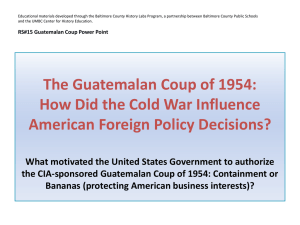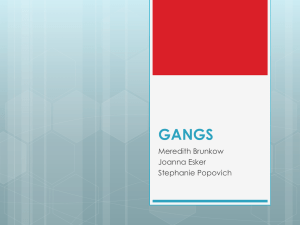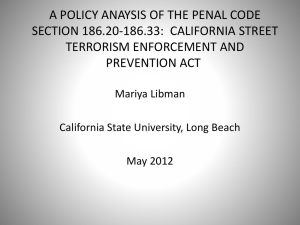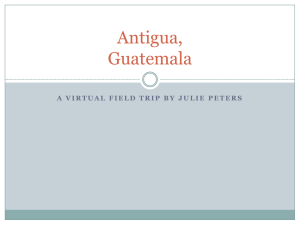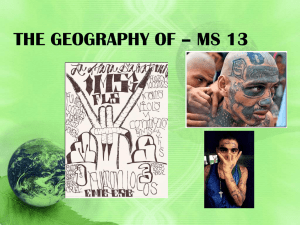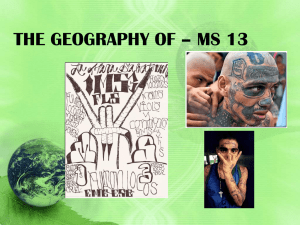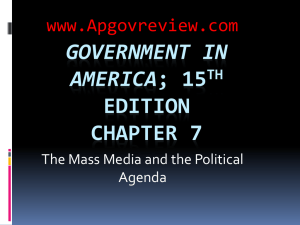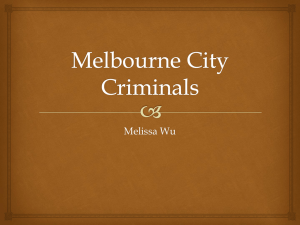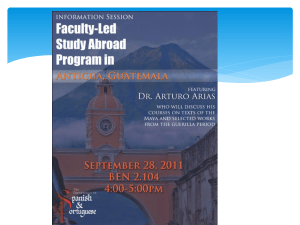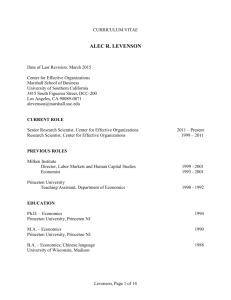Adiós Niño The gangs of Guatemala City and the politics of death
advertisement
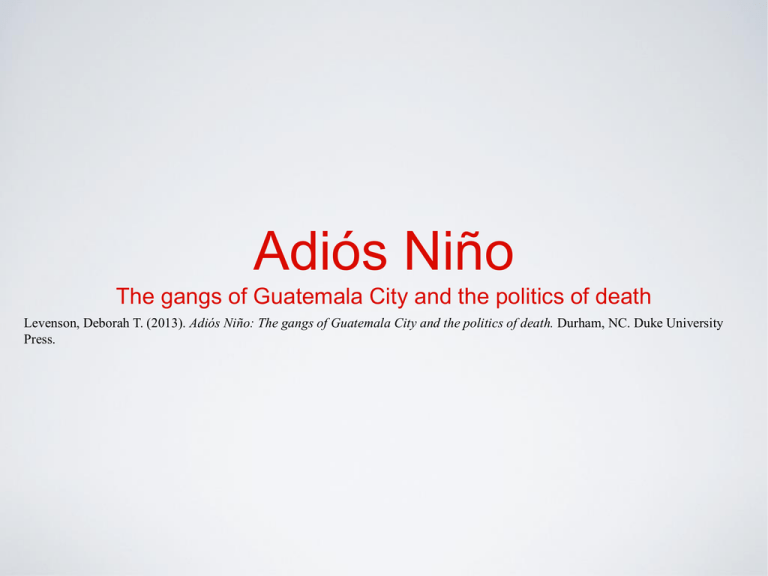
Adiós Niño The gangs of Guatemala City and the politics of death Levenson, Deborah T. (2013). Adiós Niño: The gangs of Guatemala City and the politics of death. Durham, NC. Duke University Press. Adiós Niño The gangs of Guatemala City and the politics of death • Author, Deborah T. Levenson, provides a historical look at the social and political culture of Guatemala and how that has shaped today’s violent gang presence in Guatemala City • Her personal analysis begins at her arrival in Guatemala in the late 1970’s, prior to the rise of violent street gangs • The Maras, a term used to describe the violent gangs originating in Central America today, were preceded by socially conscious and politically motivated urban youth (2, 8, 31-33) • The emergence of the Maras came in the wake of severe military action from the Guatemalan Army against political and social revolutionaries in the early 1980’s (33, 38) • The Maras originally aligned themselves with political protesters, siding with the poor and outcast in Guatemalan society (56) • The Guatemalan media, politicians, and National Police began a public campaign to portray these urban youth making up the Maras, as violent criminals, prior to any such turn in their nature (57) Adiós Niño The gangs of Guatemala City and the politics of death • Levenson notes a significant shift in youth attitudes in the mid-1980’s (56-60) • The shift coincided with global advertising efforts directed at young people to become fully engaged in the trends of consumerism (56) • Members of the Maras are called breks or mareros (55, 59). The term brek originated from a popular pastime of many of the original Maras in the 1980’s, break dancing (55) • The poor, urban youth in Guatemala had little chance of obtaining the latest and greatest in Western youth culture by way of their standard, low wage jobs • The Maras seized the opportunity to transform from left-wing political avengers of the poor to violent street gangs of youth fighting one another for anything to become less like the poor urban youth they actually were (56,72) Adiós Niño The gangs of Guatemala City and the politics of death • “I joined because there was emptiness inside me, a little loneliness, a bit of sadness...We’ve shared sorrows and joys. I think the Mara is a group of people who need affection. Some of us want to escape the mess in our homes. Sometimes we think we can create a new world.” (53) • Levenson concluded in 1987 that the Maras offered more of a peer/family environment, even “a sense of a life-affirming identity and community in the face of social decomposition.” (72) • Youth joining the Maras may initially enter out of a longing for a closeness with others and to escape personal darkness, but they quickly become hardened and tough (60, 72, 91) • The author reports that numerous studies have concluded that males make up 75% of Maras members, most come from the lower socioeconomic categories, and range in age “from six to the late twenties” (78) Adiós Niño The gangs of Guatemala City and the politics of death • Levenson describes a second shift in the culture of the Maras, that was in full effect by 2000, “It was no longer possible, as it had been in 1987, to walk down the street...and strike up a friendly conversation with young people who called themselves breks and mareros...” (78) • To demonstrate the magnitude of the growth and violent impact of the Maras by the turn of the 21st Century, Levenson shares figures from FBI data in 2000, that there were 200,000 members in Maras groups in Guatemala (78) • From time to time, police conduct sweeping raids and mass arrests throughout entire neighborhoods and communities, netting both mareros and innocent youth, many of who are never heard from again (83) • Corruption within law enforcement runs rampant in Guatemala, providing no security or comfort to the citizens (78, 83, 87) Adiós Niño The gangs of Guatemala City and the politics of death Personal Accounts from mareros • “Society isn’t ours, it belongs to others,” and “when we join the gang, we look with indifference at the rest of the world.” (95) • “Everyone sees themselves as soldiers serving mibarrio [my gang / my place] in a war without any Geneva Code.” (78) • “The devil is my jefe.” (105) • “Society hates us. They hate us, and they look at us, they see a tattoo, and they judge us. We aren’t perfect, you know. But all they think is that we are bad people. They are just assholes.” • “Forgive me mother for my crazy life” Common tattoo among mareros (95) • “In the group we learn to be bad. We like to kill. We only think about killing, about revenge, about violence. Other people’s lives don’t matter to us.” (91) Adiós Niño The gangs of Guatemala City and the politics of death Recommendation to youth development professionals I found this to be a tremendously personal, intense, and insightful look into the gang culture in Guatemala City. The focus of my review in the preceding slides was on the factual information presented by the author, Deborah T. Levenson. I believe that her presentation of her research and information gathered from other sources, woven into the real stories of the youth in Guatemala City is extremely gripping. The facts, figures, and research begin to paint the picture of life in this Central American city, but it is the voices of those that have experienced it first-hand that leave the most significant impact. The depth of Levenson’s interviews and accounts of personal experiences from herself and members of the gangs in Guatemala City, set this work apart from more strictly scholarly, impersonal accounts of the gang problems facing Central America. The quotes from various members of the gangs, in the previous slide, offer an ever so slight glimpse into the stories these youth offer Levenson. As someone who has worked with gang affiliated youth in the United States, this was still a heart-wrenching account of the perils faced by these youth even for me. I would highly recommend this book to any Youth Development Professional, specifically those working with, or interested in, the dangers and struggles of urban youth and gang culture.
